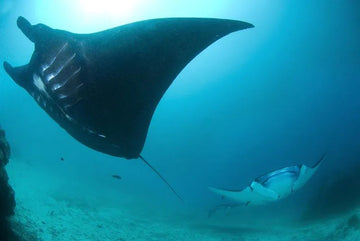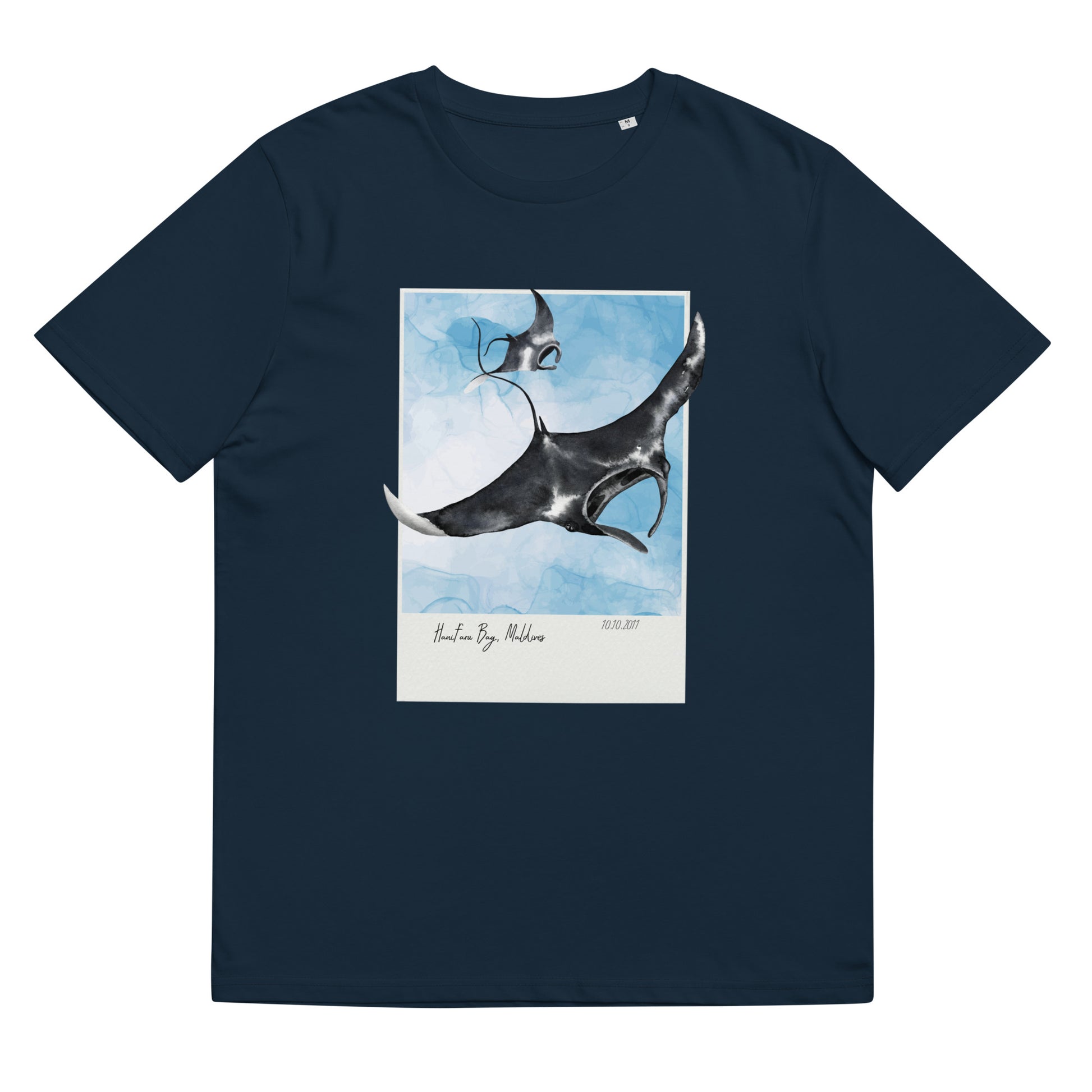Fables are defined as fictional stories starring animals or things that end with a lesson or moral that aims to teach us something and avoid mistakes... but in this fable we are going to eliminate the fictional part.
Manta rays have often been called "the pandas of the sea", and not just because of the similarity between the black and white tones of the skin of one and the fur of the other. Both species have many similarities that make it not uncommon to compare them: the wild population of both species is unknown, they are extremely vulnerable to changes in their environment that directly affect their already low birth rate (manta rays have only two offspring and take many years to reach sexual maturity). In addition, both species face serious problems that threaten their persistence on the planet. The bears seem to be on the verge of overcoming them, but the mantas are beginning to suffer seriously.
In the 1980s, the disappearance of giant pandas was a real threat. Poaching, logging, mining, and the near disappearance of their primary food source, bamboo, were all contributing factors. Today, an estimated 1,500 pandas remain in the wild, but these estimates are difficult to make due to the elusive nature of these animals. Manta rays are caught as bycatch in industrial fishing nets targeting various species of tuna, and are increasingly fished for their use in traditional Chinese medicine. Without campaigns like those developed to save panda bears, the disappearance of manta rays may be a fact of life.
T-Shirts for Manta Ray Lovers
SEE MORE MANTA RAY T-SHIRTS
Manta rays are primarily caught for their gills, as the flesh is not as tasty as that of other, more abundant fish. China (yes, China again) has attributed the gills of manta rays with the ability to cleanse the body of toxins, improve the immune system and blood circulation, and even claims that they can treat skin diseases and infertility. Various conservation organizations, such as the Manta Trust, have studied ancient traditional Chinese medicine manuals dating back more than a century and interviewed experts in traditional medicine, and the alleged benefits and references to this medicine do not appear in any text. What they have been able to confirm is that each pound of gills (about half a kilo) can be worth up to $120 on the Chinese market. Considering that each adult manta ray can yield 15 pounds of dried gills, we arrive at a not inconsiderable prescription of $1,800 per animal.
As with shark fin soup, today's Chinese can afford to pay for treatments based on manta rays. Whether they are effective is another story. The growing economic power of China's middle class is reflected in the decline of manta ray populations over the past 10 to 15 years.
Pandas were directly affected by the rapid population growth in China after 1949, which led to famine in many villages and the use of panda bears as food. In less than 10 years, the Chinese government took steps to protect pandas in the face of the catastrophe of the possible disappearance of these bears. In less than 10 years, the species was critically endangered. Today, it is the ignorance of that same population that is endangering the manta rays.

Shark fins and manta gills caught on an illegal fishing boat in Raja Ampat
The Manta Ray of Hope study claims that approximately 3,400 manta rays and 94,000 mobulas are caught each year...but these numbers only reflect reported catches. Bycatch and illegal catches greatly increase these numbers. Some data speak of a decline of up to 87% of the population in Mozambican waters due to fishing. The warning of this situation was given later than for sharks, and the data available are inaccurate due to the lack of means to carry out complete studies as they have been done for years for some shark species.
You may have seen pictures of huge schools of manta rays on your Facebook wall, and it may seem that the species is not endangered. But these pictures almost always come from the same places: Maldives, Hawaii, Indonesia or Australia, places where there are programs to protect these animals. But in the Philippines, Sri Lanka, Mexico or Thailand, they are seen (and fished) less and less. Manta rays were listed as vulnerable in 2012, and today they have been upgraded to Critically Endangered, according to the IUCN. It is one step closer to extinction.
How to save the manta rays
As we commented in a previous post on Palau's shark conservation efforts, the only way to save manta rays would be to demonstrate that they generate more money alive than dead and to push governments to impose heavy fines and prison sentences on fishermen who catch these species. Again, governments understand only the language of money and should know that fishing for these species is denying them tons of tax dollars.
Returning to the fable of the panda bears will serve as a moral. After ten years of indiscriminate hunting, habitat displacement, disappearance of bamboo forests, and reproductive problems caused by pollution and ecosystem changes, panda bears were on the verge of extinction. Only through extraordinary cooperation and marketing efforts have they made it to the present day. But what has really saved the pandas (estimated at fewer than 1,000 in the 1970s) is the money China receives from zoos that keep pandas. It is the captive pandas that keep their species alive. Pandas live because they make money.
Some marketing genius managed to create an image of these bears as adorable creatures that all children love, and this pushed zoos around the world to have one in their facilities to attract visitors. So China saw an easy way to make money by convincing zoos to pay one million dollars for each panda bear they have in their facilities, which they have to keep for at least 10 years, and on top of that, every panda born in captivity is owned by China. Who would attack a species that is adored by children and, more importantly, generates hundreds of millions of dollars a year?
How to transfer this experience to manta rays?
No, it is not about locking manta rays in giant aquariums and charging for each one. But it is about making it possible for the lovers of these animals to see them and to redirect the work of the fishermen, for example in guiding. After all, he is the one who knows the habits of manta rays best, he is the one who has been chasing them for years. Won't his family have a better future in the tourism sector, as is the case in thousands of Spanish towns? Privileged places for manta ray diving, such as Kona in Hawaii, where it is estimated that 2.5 million dollars are generated each year by snorkeling with manta rays, or the Maldives, where it is estimated that 8.1 million dollars are generated by diving with manta rays, are clear examples of the benefits of changing the activity.
In some areas, there are more than respectable, government-sponsored businesses dedicated almost exclusively to manta rays. On the island of Misool in Raja Ampat, Indonesia, they have done the math and are convinced of the environmental and, more importantly, the economic benefits of keeping manta rays alive. Working with Raja Ampat Tourism and resort associations in the area, they found that each manta ray brings in $1 million in revenue to the tourism sector over its lifetime. And we only have data from that area, we have to take into account that there are mantas that can travel up to 1,000 km, spreading wealth in the form of dive tourism across a large part of Asia. Thousands of people are willing to pay more than 3 thousand dollars every year to experience this:
Misool Eco Resort, located on the island of Misool, is a luxury resort that is largely dedicated to diving. This paradise in the heart of the Coral Triangle is located within a marine sanctuary ceded by the Indonesian government to protect and benefit from it. More than 1,200 km2 are protected from overfishing, the traditional use of dynamite or cyanide to catch fish, and shark and manta ray fishing boats. Since 2006, it has been an example of a marine park... among other things because it employs a large team of "park rangers" in charge of enforcing this status. Tourists from all over the world come here and pay between €600 and €1,500 (accommodation only) for the luxury of living and diving in a marine reserve for a week. This resort has also provided a safer, more comfortable and sustainable source of employment for fishermen and their families who have gone from plundering their ocean to serving tourists. This resort alone employs 120 people, mostly from the nearby villages of Misool, who have managed to prove Aesop's fable wrong. In Misool, 100 flying manta rays are worth more than one in your hand.
Sources:
https://www.sharksavers.org, https://www.mantarayofhope.com/, https://www.oceansentry.org/, www.wwf.es, https://www.mantatrust.org























